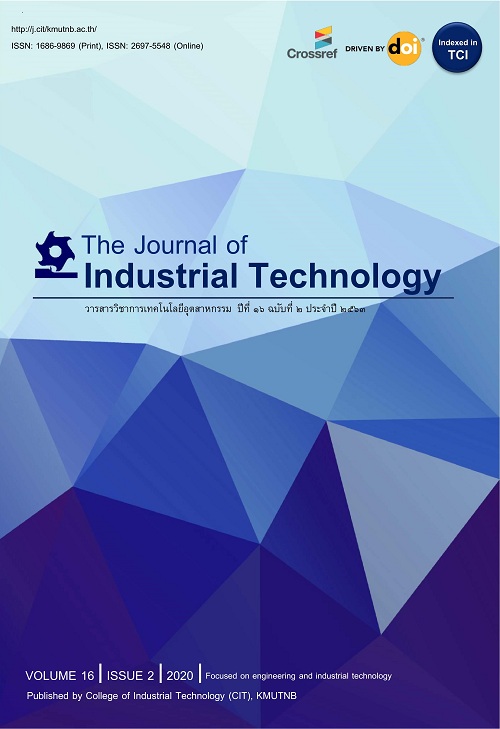Mechanical Properties and Void Formation within Injection Molded Thermoplastic Composites
สมบัติเชิงกลและการเกิดรูพรุนภายในชิ้นงานพอลิโพรพิลีนคอมโพสิตที่ผ่านกระบวนการฉีดขึ้นรูป
Abstract
งานวิจัยนี้ได้ทำการศึกษาอิทธิพลของปริมาณและความยาวเส้นใยแก้วที่มีต่อสมบัติเชิงกลและการเกิดรูพรุนภายในชิ้นงานพอลิโพรพิลีนคอมโพสิตที่ผ่านกระบวนการฉีดขึ้นรูป จากผลการทดลองโดยทั่วไปพบว่าการเพิ่มปริมาณและความยาวเส้นใยแก้วในพอลิโพรพิลีนส่งผลให้สมบัติการต้านทานต่อแรงดึงและแรงกระแทก (Tensile and Impact Strengths) มีแนวโน้มเพิ่มสูงขึ้นเมื่อเทียบกับพอลิโพรพิลีนที่ไม่ผสมเส้นใยแก้ว จากผลการวิเคราะห์ขนาดและปริมาณรูพรุนที่เกิดขึ้นภายในชิ้นงานพบว่าพอลิโพรพิลีนที่ผสมเส้นใยแก้ว 20 เปอร์เซ็นต์โดยน้ำหนัก (wt%) แสดงให้เห็นว่าเกิดรูพรุนที่บริเวณชั้นแกนกลาง (Core Layer) ของชิ้นงานในปริมาณที่น้อยมาก อย่างไรก็ตาม เมื่อปริมาณของเส้นใยแก้วเพิ่มมากขึ้น (ที่ปริมาณการผสมเส้นใยแก้วที่ 30 และ 40 wt%) พบว่าขนาดและปริมาณรูพรุนภายในชั้นแกนกลางชิ้นงานมีค่าเพิ่มขึ้นอย่างมาก ทั้งนี้ เนื่องจากอัตราการเย็นตัวและความแข็งที่บริเวณชั้นผิว (Solidified Skin Layer) ที่เพิ่มมากขึ้นจากการผสมเส้นใยแก้ว นอกจากนี้ จากผลการวิเคราะห์อิทธิพลของความยาวเส้นใยแก้วที่มีต่อปริมาณและขนาดของรูพรุนที่เกิดขึ้นยังแสดงให้เห็นว่า เมื่อความยาวเส้นใยแก้วเพิ่มมากขึ้น ส่งผลให้รูพรุนที่เกิดขึ้นภายในชิ้นงานมีขนาดใหญ่ขึ้นแต่มีปริมาณลดลง ทั้งนี้มีสาเหตุมาจากประสิทธิภาพในการถ่ายเทความร้อนที่ลดลง จากการลดลงของพื้นที่ผิวสัมผัสระหว่างเส้นใยแก้วและวัสดุเนื้อพื้น
The influences of glass-fiber length and concentration on the mechanical properties and formation of micro-voids within injection molded polypropylene composites were investigated in this work. The primary results obtained from the mechanical testing showed that the tensile and impact strength of PP composites increased with increasing fiber length and concentration. The analytical results indicated that the short-glass-fiber content of 20 wt% did not have a significant influence on the formation of voids. However, the size and content of voids within the core layer were considerably increased with the increase of fiber concentration, especially for PP filled with 30 and 40 %wt short-glass-fibers. This was due to the increase of cooling rate at the solidified skin layer by increasing glass-fiber contents. Considering the effect of fiber length on the formation of voids, it can be seen that the void contents tended to decrease whereas the size of micro-voids tended to increase with the increase of fiber length. This was due to the reduction of heat transfer efficiency caused by the decrease of contact area between the fiber surface and the polymer matrix.
Keywords
[1] S. Siengchin and R. Srisuk, Applied green composites use for automotive applications, The Journal of KMUTNB, 2017, 27(3), 405-406. (in Thai)
[2] S.M. Lee, Handbook of composite reinforcements, VCH Publishers, NY, USA, 1992.
[3] D.V. Rosato and D.V. Rosato, Injection molding handbook: The complete molding operation technology, performance, economics, 2nd ed, Springer, NY, USA, 1995.
[4] F.N. Cogswell, Polymer melt rheology: A guide for industrial practice, Woodhead Publishing Limited, London, UK, 1981.
[5] B.E. VerWeyst, C.L. Tucker, P.H. Foss, and J.F. O’Gara, Fiber orientation in 3-D injection molded features: Prediction and experiment, International Polymer Processing, 1999, 14(4), 409-420.
[6] B. Fisa and M. Rahmani, Weldline strength in injection molded glass-fiber-reinforced polypropylene, Polymer Engineering and Science, 1991, 31(18), 1330-1336.
[7] S. Patcharaphun and G. Opaskornkul, Characterization of fiber length distribution in short and long-glass-fiber-reinforced polypropylene during injection molding process, Kasetsart Journal (Natural Science), 2008, 42, 392-397.
[8] P.O. Hagstrand, F. Bonjour, and J.A.E. Manson, The influence of void content on the structural flexural performance of unidirectional glass fiber reinforced polypropylene composites, Composites Part A: Applied Science and Manufacturing, 2005, 36, 705-714.
[9] M. Gupta and K.K. Wang, Fiber orientation and mechanical properties of short-fiber-reinforced injection-molded composites: Simulated and experimental results, Polymer Composites, 1993, 14(5), 367-382.
[10] M. Akay and D.Barkley, Processing-structure-property interaction in injection molded glass-fiber-reinforced polypropylene, Composite Structure, 1985, 3(3-4), 269-293.
[11] H. Huang and R. Talreja, Effect of void geometry on elastic properties of unidirectional fiber reinforced composites, Composites Science and Technology, 2005, 65(13), 1964-1981.
[12] Y.K. Hamidi, L. Aktas, and M.C. Altan, Effect of packing on void morphology in resin transfer molded E-glass/epoxy composites, Polymer Composites, 2005, 26(5), 614-627.
[13] A. Vaxman, M. Narkis, A. Siegmann, and S. Kenig, Void formation in short-fiber thermoplastic composites, Polymer Composites, 1989, 10(6), 449-453.
[14] G. Saint-Martin, F. Schmidt, P. Devos, and C. Levaillant, Voids in short fiber reinforced injection molded parts: density control vs. mass control, Polymer Testing, 2003, 22(8), 947-953.
[15] I.S. Miles and S. Rostami, Multi-component Polymer System, Polymer Science and Technology Sires, Longman Scientific & Technical Publisher, NY, USA, 1992.
[16] J. Karger-Kocsis and K. Friedrich, Fatigue crack propagation in short and long fiber reinforced injection molded PA 6.6 composites, Composites, 1988, 19(2), 105-114.
[17] Bakelite AG / KISTLER, Defects on Injection Molded Parts, Germany.
[18] D. Frihi, A. Layachi, S. Gherib, G. Stoclet, K. Masenelli-Varlot, H. Satha, and R. Seguela, Crystallization of glass-fiber-reinforced polyamide 66 composites: Influence of glass-fiber content and cooling rate, Composites Science and Technology, 2016, 130(17), 70-77.
DOI: 10.14416/j.ind.tech.2022.08.008
Refbacks
- There are currently no refbacks.






